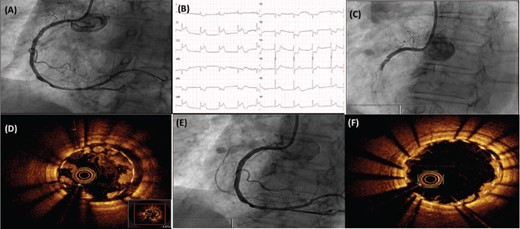-
PDF
- Split View
-
Views
-
Cite
Cite
Juan Jose Portero-Portaz, Juan Gabriel Córdoba-Soriano, Juan Carlos Gallego-Page, Type III Kounis syndrome after administration of an echocardiography contrast agent, European Heart Journal. Acute Cardiovascular Care, Volume 9, Issue 6, 1 September 2020, Pages NP1–NP2, https://doi.org/10.1177/2048872616655943
Close - Share Icon Share
Abstract
A dobutamine stress echocardiogram was performed in a 72-year-old woman to assess an intermediate lesion in the left anterior descending artery. After administration of the echocardiography contrast agent, she presented with an anaphylactic reaction and in that context a subacute thrombosis of a drug-eluting stent implanted 15 days before. This is a case of the so-called type III Kounis syndrome.
A 72-year-old woman attended for a dobutamine stress echocardiogram to be performed to assess an intermediate lesion in the mid-left anterior descending artery. Background included a recent (15 days) inferior ST-segment elevation myocardial infarction with a drug-eluting stent implantation (Figure 1 (a)) in the right coronary artery (RCA). After the administration of 5 mg of the regular echocardiography contrast agent with sulphur hexafluoride (SonuVue) used in our laboratory, the patient presented with discomfort, profuse sweating and dyspnoea. In the physical examination an exanthema, hypotension and scattered pulmonary wheezing were objectified and she was treated with hydrocortisone. A few minutes later she presented with typical chest pain and the ECG showed ST-segment elevation on inferior leads (Figure 1 (b)). She underwent emergency catheterisation and a stent thrombosis in the RCA was observed (Figure 1 (c)). After thrombus aspiration an optical coherence tomography showed a small malapposition of the stent (Figure 1 (d)). Simple balloon angioplasty achieved good apposition (Figure 1 (f)) with TIMI III flow (Figure 1 (e)). The concurrence of acute coronary syndromes with anaphylactic reactions is the so-called Kounis syndrome,1 of which type III corresponds to a stent thrombosis. Despite pharmacovigilance studies2 having detected a SonoVue severe side effect rate of 0.014% (only 18 cases described as serious allergic reactions), the concurrence of anaphylactic reactions with stent thrombosis has not previously been reported.3 In addition, the hypotension may have also contributed to the malapposed stent thrombosis. Future registries might determine the safer form to manage this useful tool at the echo laboratory.

Angiographic, electrocardiographic, and optical coherence tomography image composition.
The authors declare that there is no conflict of interest.
This research received no specific grant from any funding agency in the public, commercial, or not-for-profit sectors.




Comments